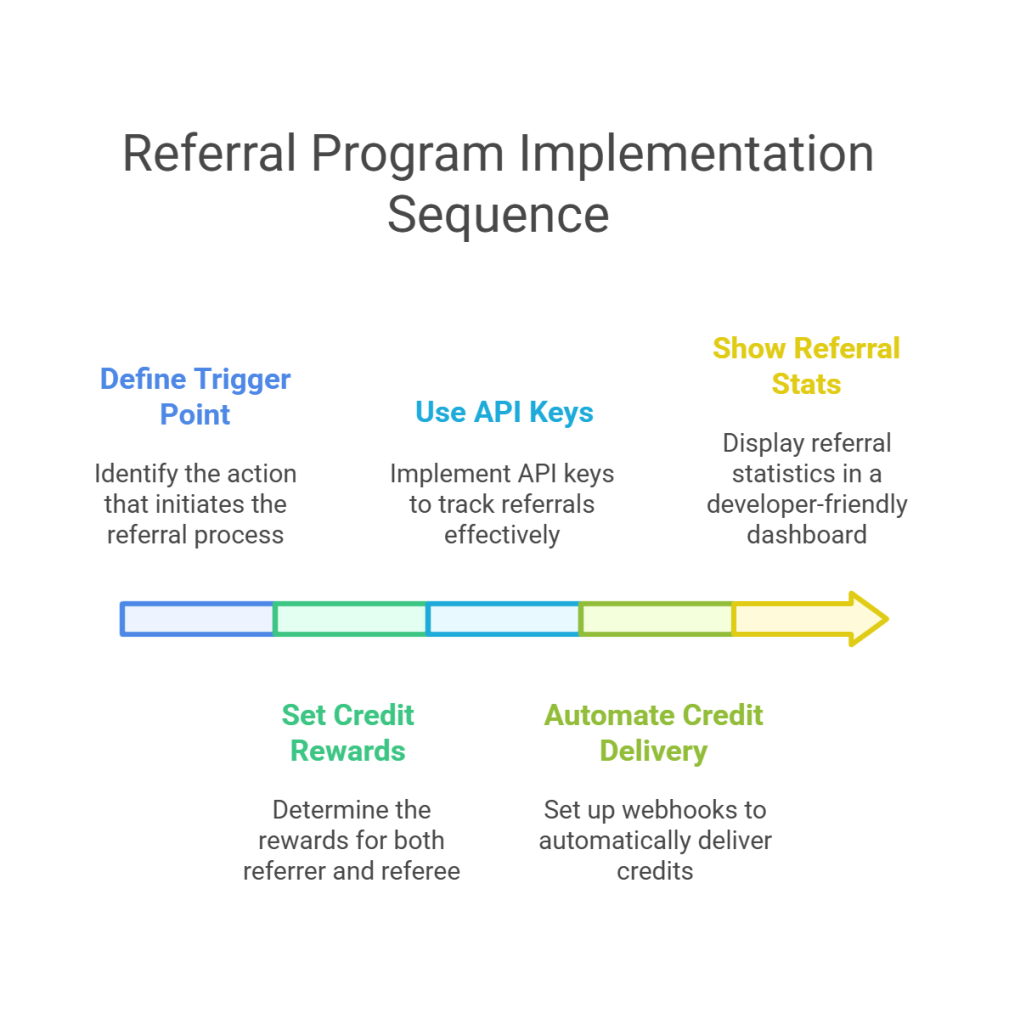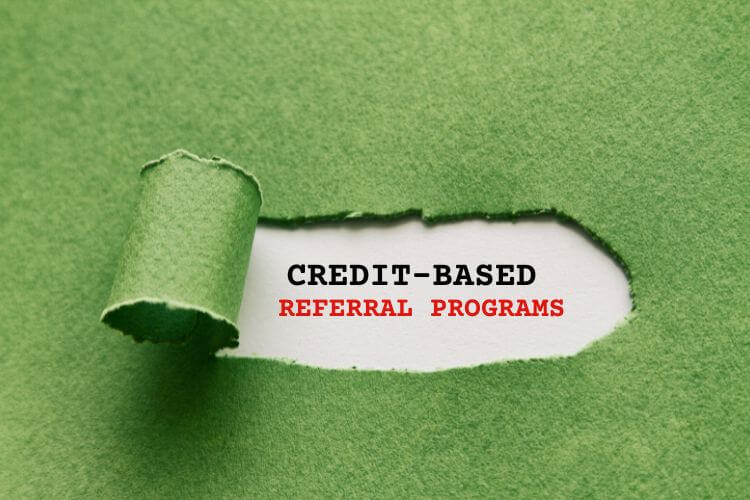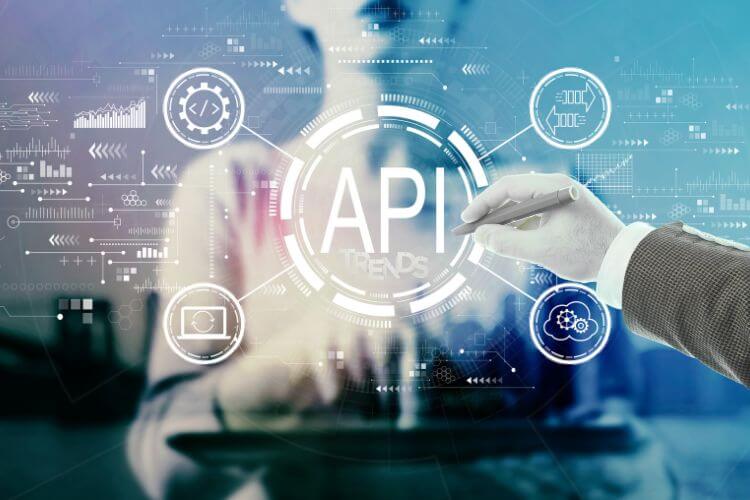How to Build a Developer-Friendly API Referral Program That Scales Usage
Referral marketing works great in theory. But when you’re building a developer-first product, especially one that’s API-first with REST API capabilities, things get a little weird. Developers don’t respond well to fluffy promos or generic referral codes. They care about tools that solve problems, clean systems that don’t waste their time, and rewards that actually help them build more through effective marketing programs.
So, how do you create a referral program that developers don’t hate and actually use with API access? Enter the API credit loop: a usage-based referral system that rewards real product adoption through a REST API, not just clicks or signups.
Why Traditional Referral Programs Don’t Work for Dev-First Products

Developers Don’t Share “Just Because”
Developers have a radar for BS in marketing campaigns, especially when they involve customer data. If your referral program feels like a shallow marketing gimmick, they won’t touch it. Devs take pride in the tools they recommend, so if your product isn’t rock-solid or the reward feels misaligned, they’re out. As one Reddit user put it, “If a dev shares your product, it means they vouch for it, driving new customer acquisition.” You can’t buy that with $10 coupons; true value comes when a customer makes a purchase.
Promo Codes Feel Like Marketing Gimmicks
Traditional referral programs rely on codes or links that feel clunky when integrated into developer workflows, but ReferralRock’s solution is a more technical and user-friendly referral API. No one wants to mess with adding referral codes to a Postman collection or CLI setup. It feels unnatural and often disrupts the dev flow.
Why Usage-Based Products Require Usage-Based Loops
If your SaaS pricing is based on API usage, then your referral strategy should mirror that. Instead of giving away discounts for email signups, reward real usage milestones like API requests made, endpoints hit, or integrated features. That way, you’re growing with quality users who actually build, not just browse.
What Is the API Credit Loop?

The API credit loop flips the traditional referral model. Instead of paying users for bringing in traffic or signups, you give them credits when their referred users start using your API in a meaningful way.
Let’s say a dev invites a friend to try your product, leveraging word of mouth for better customer engagement. That friend builds something, hits 1,000 API calls, and boom, the original referrer gets 500 usage credits. These credits fuel more usage, which means more adoption through the best referral software, and the loop continues.
How the loop works:
Dev A shares the SDK link > Dev B builds with it > Dev B hits the usage threshold > Dev A gets credits > Dev A builds more > Dev A shares more Loop.
How to Build a Usage-Triggered API Referral Program Without Feeling Spammy

1. Define Your Trigger Point
Pick a metric that signals meaningful product use. That could be an incentive for new customers.
- 1,000 API calls
- 10 user authentications
- 500MB of logs ingested
Make sure it’s tied to value, not just activity. Don’t reward devs when someone signs up and pokes around without API integration. Reward them when that user hits a real milestone.
2. Set Credit Rewards for Referrer and Referee
Tiered rewards work well. They add progression and give devs something to aim for.
- 1K calls: 500 credits
- 10K calls: 2,000 credits
- 50K calls: 10,000 credits
Also, consider rewarding the referred dev. Everyone likes free fuel to build.
3. Use API Keys to Track Referrals
Each referral can carry a unique tag via the SDK or API key. That tag lives in the metadata and follows the user through the onboarding and usage process. You can build this natively or use tools like Segment or Mixpanel to help.
4. Automate Credit Delivery Using Webhooks
Once your referral system detects that a usage threshold has been crossed, trigger a webhook to your billing system. That webhook allocates usage credits to the referrer (and maybe referee) in the referral program software, enhancing the customer loyalty experience.
You can build this in-house or use something like Zapier, Workato, or even Firebase Functions.
5. Show Referral Stats in a Dev-Friendly Dashboard
Don’t bury this data. Devs want to see it. A clean dashboard that shows API usage data and referral program features:
- Number of referred teams
- Which ones are active
- Credits earned
- Upcoming reward milestones
Transparency makes devs feel like they’re part of the system, not just being gamed by it, fostering customer loyalty.
Real-World Examples

Supabase: Organic Growth via SDK Sharing
Supabase didn’t start with a referral program. They built something devs loved, and those devs naturally shared SDKs in GitHub repos, blog posts, and community Slack channels, increasing the visibility of their tools through referral marketing software. The result? Viral growth without a formal referral system can still be achieved through devtools.
Clerk.dev: Credit-Based Advocate Loop
The clerk offers usage credits for referrals, but it’s subtle in its referral program integration. No email chains or spammy invites. Just “Build cool stuff, refer someone, get more fuel to build through the referral factory.”
Hasura: Tiered Recognition + Referrals
Hasura rewards devs who contribute and refer others. Their system blends community, open-source contribution, and product adoption into one unified loop.
How to Prevent Abuse in Credit-Based Referral Programs

Use Behavioral Analytics to Spot Fraud
Track IPs, domain names, workspace patterns, and behavior trails. If 10 accounts come from the same IP and never hit real usage, flag it to ensure the integrity of the referral API.
Add Friction Where Needed
Don’t make everyone go through KYC. But if someone refers 100 “users” in a day, maybe dig deeper.
Block Self-Referrals by Matching Email Domains
Simple checks like comparing referral and referee domain names can prevent abuse, especially in B2B or team environments.
Developer-Focused Copywriting Tips for Referral Prompts

Say “Earn Credits,” Not “Invite Friends”
Words matter in building a referral program. Saying “Refer a friend and get $10” screams marketing campaigns. “Earn 500 credits when your SDK powers a launch” speaks to the dev and serves as an incentive-based approach.
Embed CTAs Where Devs Already Are
- CLI tools: API-tool referral
- SDK logs: Show prompts after the first successful request to encourage API access and improve customer loyalty.
- Postman/Insomnia: Add “Fork & Refer” in the collection UI
Make it feel native, not bolted on.
Bonus: Free Tools & APIs to Build Your Referral System Fast
Open-Source Goodies
- ReferralHero JS SDK: It is designed to streamline your incentive-based campaigns.
- Firebase Cloud Functions starter kits
API-Driven Referral Software
- Referral Rock API: Fully customizable
- Talon.One: Rule-based reward engine
- Friendbuy: Plug-and-play for dev-heavy platforms can significantly enhance referral program integration.
The Growth Math: Why Credit-Based Loops Outperform Discount Codes
Discounts kill margin. Credits drive adoption and can be tracked through CRM systems.
Let’s say a $10 discount for a referred customer gets you a signup. Cool, especially when you consider how it can enhance your referral marketing software. But 1,000 free API calls? That might get you 3,000 more in usage once the dev is hooked, thanks to the referral to Rock’s program.
You’re not giving away money. You’re seeding usage through a referral campaign that integrates referral automation.
That’s why usage-based referral loops tend to outperform flat promos, especially for API-first SaaS.
Future Trends: Where API-Based Referral Programs Are Headed

Wallet-Based Referrals
Web3 devs already use wallet signatures to verify identity. Expect referral rewards tied to wallet-based invites soon, enhancing customer loyalty.
GPT + Referral Generators
Tools that generate dev blogs or SDK demos with built-in referral links are coming. Think “one-click growth loops via content.”
Deep Integration in Dev Tools
Imagine referral stats baked into VSCode extensions or GitHub workflows. It’s coming. And it’s going to feel native.
Final Thoughts: Respecting Developers While Driving Growth
If your product helps devs build faster, cheaper, or better, they’ll share it through Referrals program. But only if you make that sharing natural, respectful, and tied to real value will your PLG strategy be enhanced.
The API credit loop works because it rewards the right behavior, real adoption, and customer loyalty. And it does so in a way that developers don’t just tolerate but appreciate.
FAQs: Your Burning Questions About Referral Program with API
Do I need referral codes or links to implement a successful referral campaign?
Not really; the integration of a RESTful API is essential. You can use the SDK metadata and API keys or install tags to track referrals.
What if the referred user signs up but doesn’t use the product?
Then they don’t get rewarded, and neither does the referrer. That’s the point.
How much credit should I give to tailor the rewards effectively within the loyalty program software?
Just enough to explore. Maybe 500 calls, 100 auths, and 1,000 logs through the REST API.
Can I track referrals without emails?
Yes, integrating an API allows for seamless management of referral processes. Use workspace IDs, unique SDK tags, or CLI install fingerprints.
Will this work for B2B APIs that allow for seamless integration?
Absolutely, especially for infra, auth, and logging APIs where usage = value.
